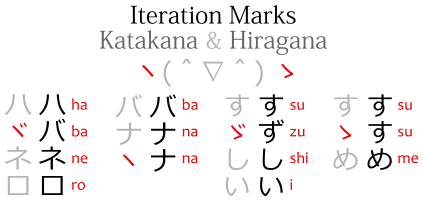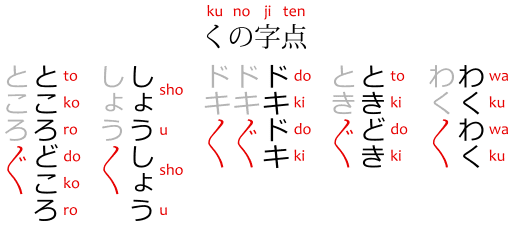In Japanese, the symbols ゝゞヽヾ are iteration marks for kana (hiragana and katakana). They work just like 々 works for kanji, by repeating the character that precedes them, except that, while 々 is commonly used, ゝゞヽヾ are rarely used in modern Japanese.
Note: if you saw ヽ in the furigana space, that's probably an emphasis mark instead.
The differences between the five symbols are pretty simple:
- 々 is used with kanji.
- ゝ and ゞ are used with hiragana.
- ヽ and ヾ are used with katakana.
- ゞ and ヾ add a dakuten ゛ accent.
- ゝ and ヽ remove the accent.
The symbols ゝゞヽヾ are called ichi-no-ji-ten 一の字点, "character mark [that looks like] 一," but they're also known by the same names 々 has: kurikaeshi 繰り返し, odoriji 踊り字, etc.
Used Less
The main use of kurikaeshi 々 is to save time and effort when writing words that have the same kanji twice (feature reduplication) by handwriting the simpler 々 instead of a more complicated kanji.
Since most kana are much simpler to write by hand than most kanji, ゝゞヽヾ aren't used as much as 々. (like, why would you write tsutsu つゝ instead of tsutsu つつ? What time are you saving? Sure it's a single swift stroke, but how lazy can ppl b?)
Literary Application in Post-War Meme Culture
In the era of typing on computers and phones, it ironically takes longer to type those marks than to just repeat the kana literally. Online, you're more likely to encounter them in kaomoji 顔文字.
I'm not even joking. ヽ(・ω・)ゝ
Really not. (ゝω・)
Nope. ( ´◔‿ゝ◔`)
It's Spelled Like This!
Another case you might find online are official spellings of things. For example, a novel by Natsume Souseki 夏目漱石, published a century ago (1914), was officially entitled Kokoro こゝろ. Nowadays, it's also spelled Kokoro こころ, but some manga adaptations of that novel kept the こゝろ spelling.
Another novel, Aa, Kouya あゝ、荒野, published in 1966 by a different author, got a (non-anime) film adaptation in 2017, which kept that spelling. (I suppose with vowel it has the same effect as ー, like aa あー.)
Another case are names of people, things and characters, like Nonoka のゝか or Suzume すゞめ.
But then again anything goes in names. There's even a character called Chudai ゝ大(anidb.net). I have no idea how it's read Chudai, but it is.
There's also a company called Esu Sゝゝ. No, not Esu-Esu-Esu SSS, as you'd expect from repeating the katakanization of the alphabet letter. Just Esu エス, but spelled Sゝゝ.(sss-s.jp)
Real-Life™ Usage
Outside the horizontally-written virtual world, the kana iteration marks are still used in the real-world.(chiebukuro:「ゝ」や「ゞ」)
Including in official documents.(chiebukuro:踊り字(々)は)
As you might have noticed, or rather, not noticed, although the symbols are still used—they haven't been deemed "archaic" yet—they pretty much can't be found in any manga. Or basically any publication.
This is because we live in the 20 century and printed media is written on computers, not parchment. So you gotta type those characters. And, again, it doesn't really save time typing those on a computer. So they appear less. People see it less. Use it less. So they appear less. People see it less. Use it less. And so on.
In real-life vertical writing, in words that don't have kanji, or that are written without kanji, including words that repeat themselves, like a number of mimetic words and onomatopoeia, they may still be useful, if you want to write something real fast, like on a blackboard, for example.
Examples
Here are some examples of how they work.
You'll see that they simply replace the repeating character:
- kokoro こころ
kokoro こゝろ
Heart. Mind. Should. - susume すすめ
susume すゝめ
Recommendation. - tsutsu つつ
tsutsu つゝ
(particle: marks something continually done.)
So it's not really complicated.
Wrong Examples
The only rule regarding these iteration marks is that they can only repeat the kana actually written before them, they can't repeat the unwritten kana readings of a kanji. For example(chiebukuro:くの字点や):
- iimasu 言います
iimasu いいます
To say. - iimasu いゝます
(correct.) iimasu 言ゝます
(wrong.)
ゝ vs. ゞ, ヽ vs. ヾ
The difference between ゝ and ゞ, and ヽ and ヾ, is that, although they all repeat the kana, ゝヽ won't have the accent while ゞヾ will. That is:
- kaka かゝ = かか.
- kaga かゞ = かが.
- gaka がゝ = がか.
- gaga がゞ = がが.
Note that, to some people, ゝ copies the whole thing, so gaga がが would be がゝ, not がゞ. (chiebukuro:踊り字の使い方)
Some examples in real words:
- atatakai あたたかい
atatakai あたゝかい
Warm. - suzushii すずしい
suzushii すゞしい
Cool. Refreshing. - jijitsu じじつ
jijitsu じゞつ
Truth. - tegakari 手がかり
tegakari 手がゝり
Clues. Leads.
ヽヾ & Katakana
Below some katakana examples:
- banana バナナ
banana バナヽ
(oh well, I wonder what this word could possibly mean...) - habanero ハバネロ
habanero ハヾネロ
(this is a pepper.) - hahahahahaha ハハハハハハ
hahahahahaha ハヽヽヽヽヽ
*laughs iteratively*
Although the difference between ゝ and ヽ would be that you use one for hiragana and the other for katakana, to some people ゝ is used in both cases, as a general repeating character. (these people probably don't even know ヽ exists, by the way.)
ゝゝ - Double Iteration
Also like 々, kana iteration marks can iterate multiple characters in sequence. For example:
- wakuwaku わくわく
wakuwaku わくゝゝ
*excitement*
Long く
Note that in this case, but in vertical writing, you might get a ku-no-ji-ten くの字点 instead. Which is, literally, a twice as long ku く character that's used to iterate multiple characters at once.
In horizontal writing it becomes a he へ, like:
- wakuwaku わく〳〵
- wakuwaku わく/\
Mixed Accent
The kana iterations marks can also be mixed when rendaku 連濁 changes the pronunciation of a syllable, for example:
- tsukudzuku つくづく
tsukudzuku つくゞゝ
Utterly. - tokorodokoro ところどころ or 所所
tokorodokoro ところゞゝゝor 所々
Here and there. In several places.
With a Single Character
It's also considered valid to use a single character instead of two in these cases.
- wakuwaku わくゝ
With rendaku it must be the accented version.
- tokoro-dokoro ところゞ
- kureguremo くれぐれも
kureguremo くれゞも
Earnestly.
References
- Chudai - anidb.net, accessed 2021-08-03.
- Sゝゝ - sss-s.jp, accessed 2021-08-03.
- 「ゝ」や「ゞ」などの踊り字は最近使われませんよね? - detail.chiebukuro.yahoo.co.jp, accessed 2021-08-03.
- 踊り字(々)は、正式な文書では使ってはいけませんよね? - detail.chiebukuro.yahoo.co.jp, accessed 2021-08-03.
- 踊り字の使い方 - detail.chiebukuro.yahoo.co.jp, accessed 2021-08-03.
- くの字点や、一の字点の使用について。 - detail.chiebukuro.yahoo.co.jp, accessed 2021-08-03.


No comments: